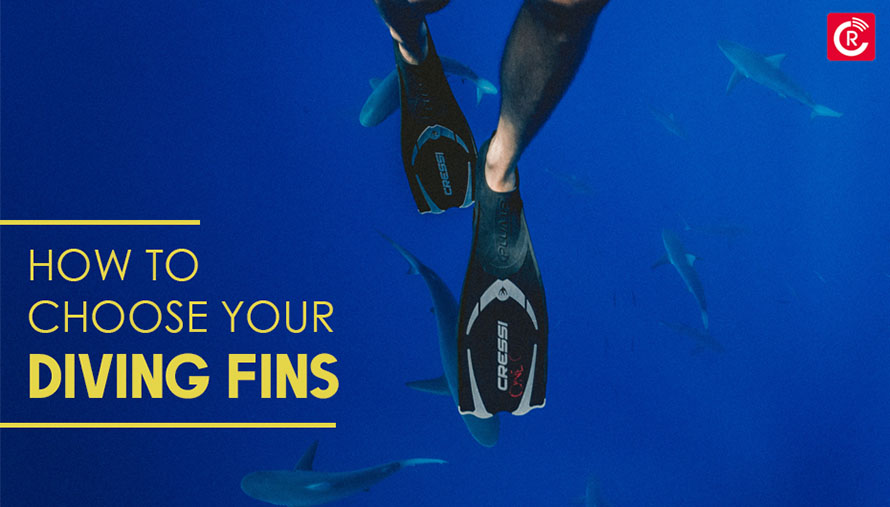
When it comes to the adventure of diving, having the right pair of fins can make a world of difference. The key component of diving equipment is fins. Fins are also popularly known as diving fins, scuba fins, blades, and flippers.
They help to move smoothly and get around underwater. Fins are a vital gear whether doing swimming, diving, or snorkeling. This article delves deeper into choosing the right diving fins.
Diving and Fins
Scuba fins are directly linked to the amount of air and energy you consume on the drive. Therefore, the right pairs of fins can help in dramatically increasing the bottom time during scuba dive. The main purpose of scuba diving is to move more efficiently and swiftly underwater with less effort.
Divers don’t need to use their hands to move underwater because the fins provide a wider area to move and push against the water. From the first time fins are invented and designed, they have come a long way over the year. In the past, fins were made from wood and were tied to the foot while diving.
In diving and daily fishing activity, some of the local fishermen in Asia use fins made of plastic and wood. Nowadays, because of high technology, the modern fins are more appealing, comfortable, and streamlined than the wooden fins. It is possible only after various research on creating and developing fins using different designs and materials, which helps in promoting comfort, efficiency and minimize kicking efforts underwater.
Generally, diving fins are made of polypropylene, plastic, and rubber. Compared to other technologically and sophisticated scuba gear such as BCDs and regulators, fins are considered more comfortable and affordable. New divers bring fins as one of the first pieces of essential equipment.
How To Choose The Best Diving Fins?
No doubt there are various types of fins available in the market. But the main question that arises is what types of fins should be suitable for better diving. Sometimes this question and availability of fins in vast numbers make the task of selection overwhelming. While choosing fins, you should always consider your leg power, diving experience, and the type of diving you will do. So it comes down to two factors while choosing the best dive fins your personal preference and your style of diving.
Where will you dive?
The surrounding environment, water temperature, and currents need to be considered while choosing the best fin for dive. For tropical water on a shallow reef, flexible and lightweight full-foot fins work fine. And for wreak and cave, which works well with frog kick to help maneuver in tight space. If you were traveling and need fins that easily come in your travel bag, you might choose a shorter and lighter fin for a better fit.
How you prefer to kick?
Some of the fins are designed to work better with a flutter kick, while others perform best with a frog kick. In addition, some divers want little resistance with high flexibility, creating a cadence faster when they kick, while others want less resistance to kick less frequently.
Full foot fins
Full foot fins have a closed heel which is generally worn with neoprene thin fin sock or barefoot for more comfort. These types of fins are generally for snorkeling on the surface or for diving in warm tropical water. They are lighter and have a low cost as compared to open heal fins. Generally, In warm water, you need less diving equipment to move with less mass; that’s why you find full-fed fins that are more comfortable and flexible.
Open heel fins
You will find most of the scuba diving fins are adjustable open-heel fins. Which requires neoprene boots to wear to use underwater, and it is ideal for diving in cold water. Keeping the foot secure in the pocket is designed with an open foot and has an adjustable heel strap.
Diving in colder water requires more equipment to wear, which equates to mass moving easily through the water. Generally, open heel fins are made from stronger material, stiffer than full foot fins. Therefore, it is advised first to buy booties and then buy open heel fins. Because the thickness of booties will decide the fit and size of the fins, booties will come in different sizes.
Blade style
Over the year, the diving fins have evolved. Nowadays, fin blades are larger and more efficient than their predecessors. To increase performance and move the body with minimum efforts through the water, manufacturers join mixtures of material and technologies.
There are different types of blade types available in the market, which are:-
Paddle or standard fins –
This type of fin blade is flat, spills water over the fin sides, helps to create turbulence, and reduces efficiency. Generally, it has the simplest design and a flat-based surface. They work like an ore principle, with every kick it propelling you forward.
Vented fins –
From standard fins, vented fins are a step up. At the base of the foot, It is padded fins are vented. During the kick cycle of recovery stroke, the vents allow water to go through the fin, which helps prevent water from passing during the power stroke, which helps in increasing kick efficiency and reduces efforts during stroke recovery.
In addition, to increase propulsion, some vented fins are designed to stream water over the fins’ blade length.
Channel fins –
Different materials are used in channel fins to flex along the fin blade’s width. It is done by using softer material with rigged fin material. While kick, the channel fin forms a “u” shape channel that helps to contain and capture the water more efficiently rather than just having ribs on the boundary of the fins. It increases propulsion by creating a focus “jet” of water.
Split fins –
Split fins have split in the down middle of the blade, and for the support, it has stiffer sidewalls. Same as other fins, these fins also recoil to give thrust. Split fins work similarly to the boat propellers and plane wings. Splits in the fins make it easy for water to pass through, making it easy to kick the fins and reduce the load on the leg and ankles.
But if you are using the frog kick while diving, it is not the ideal fins as it can be hard to maneuver sometimes.
Hinged fins –
In fin designs, hinged fins are fairly the new ones. This type of fin has a point on a blade that hinges. The hinge on the blade allows you to move to the best angle on the power stroke attack, which also helps in improving your performance. In many ways, this technology is used. For example, some manufacturers use narrow sections and bungee bands flexing bars and blades to create more efficient fins.
Flippable fins –
It is the newest and most versatile style of fins available in the market. Flippable fins can be folded and flipped out easily on the way, which allows divers to walk on the surface without removing it. It is convenient and beneficial to those divers who need to climb ladders or walk down to get on and off the water.
The amazing feature of these fins is that the blades automatically flip down and lock into place when you start kicking in the water.
Straps and buckles –
Fins straps and buckles are designed to make it as easy as possible to take off the fins. Fins straps and buckles are designed to allow you to loosen and tighten the straps.
Quick-release buckles –
You can easily remove your fins without removing and losing the straps with the help of quick-release buckles. It saves time and helps you to keep desired tension without making adjustments before your dive. The buckles can be folded out themselves, extending the strap that takes off the fins and then folded back to restore the normal straps before dive.
Spring straps –
Spring straps replace the buckle and rubber straps system. To give strap tension, it uses a bungee or stainless steel spring. It is normally a loop at the back of the strap, which helps pull the strap over the heel. The tension from bungee or spring helps keep your foot safe and protected in the foot pocket and automatically adjust when diving at depths.
Conclusion
While choosing fins, make it clear that all fins are not created equal. In designing each pair of fins, a great deal of research and science goes on. With each kick cycle, the energy released from the leg and transfer to the fin is considered by manufacturers, and then they combine many blade designs and materials to make it simple for divers.
However, your personal preference, the environment you will be diving in, and the type of diver you have to be determined before choosing the fins. It would be best to try different fins and styles to find the best one for your dive. Before settling with one, try a few out first.





